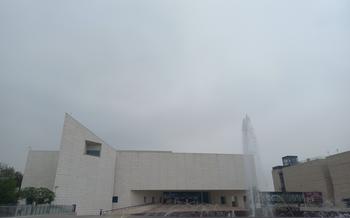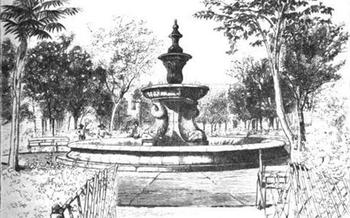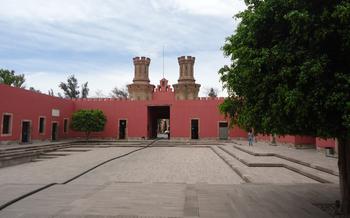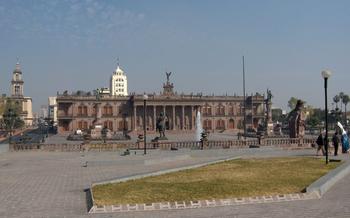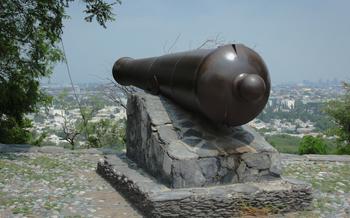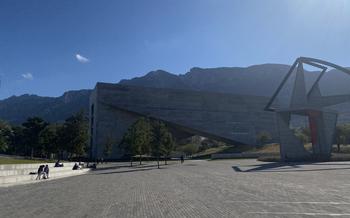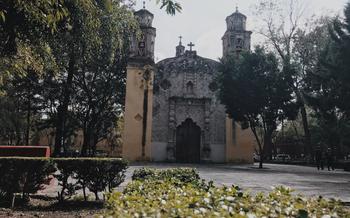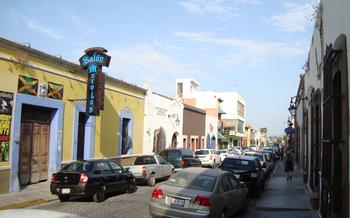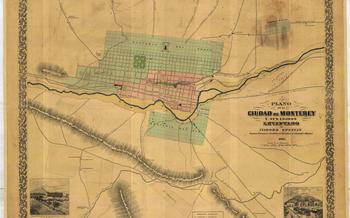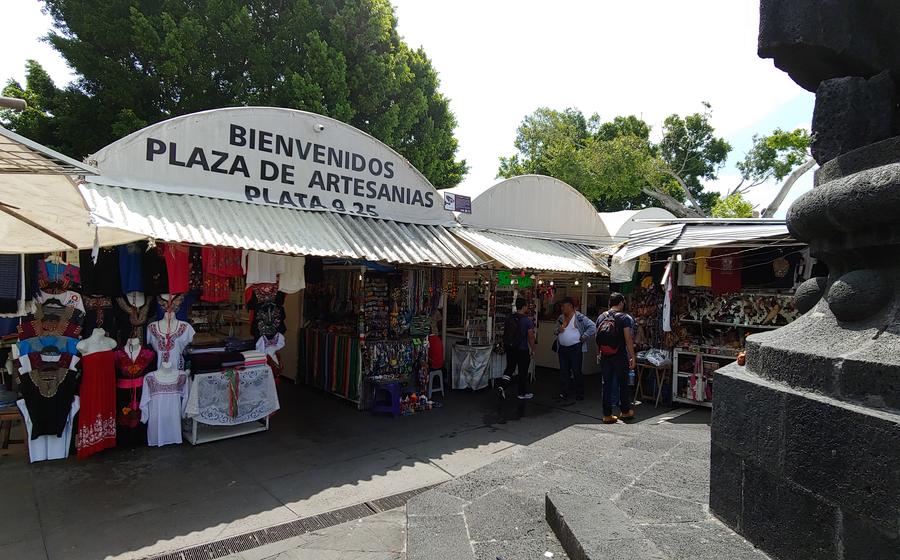
Plaza Morelos
- Historical Significance
- Central Location:
- Macroplaza Development
- Government Buildings
- Museo de Historia Mexicana: A Journey Through Time
- Plaza Morelos: A Meeting Point
- Cathedral of Monterrey: A Majestic Symbol of Faith
- Arquitectos Building: A Symbol of Progress and Innovation
- Obispado Museum: A Window into History and Art
- Cerro de la Silla: Monterrey's Iconic Mountain
- Contemporary Art Museum of Monterrey (MARCO):
- Insider Tip:
Historical Significance
Plaza Morelos, formerly known as Plaza Zaragoza, holds a significant place in the history of Monterrey. It was established in 1596 as the main square of the newly founded city of Nuestra Señora de Monterrey. The plaza served as a marketplace, a gathering place for public events, and the seat of local government. Over the centuries, it witnessed numerous historical events, including the Mexican War of Independence and the American Civil War. The plaza underwent several transformations, reflecting the changing times and architectural styles, but it remained the heart of Monterrey, a symbol of its rich history and vibrant culture.
Central Location:
Plaza Morelos's strategic position in the heart of Monterrey makes it a convenient starting point for exploring the city's historical and cultural attractions. Within easy walking distance, visitors can find themselves immersed in the colonial charm of the Barrio Antiguo, marvel at the grandeur of the Palacio de Gobierno, or soak in the tranquility of the Jardín Hidalgo. The Macroplaza, a modern urban development project, seamlessly blends historical landmarks with contemporary architecture, offering a glimpse into Monterrey's rich past and vibrant present.
For those seeking a deeper understanding of the city's heritage, the Museo de Historia Mexicana, located just a stone's throw away from the Plaza, houses a comprehensive collection of artifacts and exhibits that narrate the captivating story of Monterrey's transformation from a humble settlement to a thriving metropolis. The Cathedral of Monterrey, an architectural masterpiece that dominates the city's skyline, is another must-see attraction, beckoning visitors with its serene ambiance and historical significance.
With convenient access to public transportation, including the Metrorrey subway system, getting to and from Plaza Morelos is a breeze. The surrounding neighborhoods, such as the trendy Barrio Antiguo and the vibrant Centro Histórico, offer a diverse range of culinary delights, shopping experiences, and cultural attractions, ensuring that there's never a dull moment for visitors to this central hub.
Macroplaza Development
In the 1980s, Monterrey embarked on an ambitious urban renewal project, transforming the city center and creating the Macroplaza - a vast, modern plaza that seamlessly integrates historical landmarks with contemporary architecture. The project aimed to revitalize the city's core, enhance its cultural identity, and create a vibrant urban space for residents and visitors alike.
The Macroplaza project involved the demolition of several old buildings, the construction of new structures, and the renovation of existing ones. The result is a harmonious blend of historical and modern elements that showcase Monterrey's rich heritage while embracing its urban transformation. The plaza's expansive open spaces, contemporary art installations, and beautifully landscaped gardens create a welcoming and dynamic environment that attracts locals and tourists.
The Macroplaza's integration of historical and modern elements is particularly noteworthy. The plaza incorporates existing landmarks such as the Catedral Metropolitana de Monterrey and the Palacio de Gobierno, while surrounding them with modern structures like the Museo de Historia Mexicana and the Torre Administrativa. This juxtaposition creates a visually striking and historically significant urban landscape that celebrates Monterrey's past and present.
Government Buildings
At the heart of the Plaza Morelos stands the majestic Palacio de Gobierno, an architectural masterpiece boasting an impressive neoclassical façade and intricate detailing. This iconic building serves as the seat of the state government, housing various government offices and administrative departments. Its grand entrance, adorned with imposing columns and ornate carvings, welcomes visitors into a world of historical significance and political power.
The Palacio de Gobierno has witnessed pivotal moments in Monterrey's history, playing a crucial role in shaping the city's political landscape. Within its walls, important decisions have been made, laws have been enacted, and policies have been implemented, guiding the development and progress of the region. The building's stately presence reflects the authority and influence of the government institutions that reside within.
Apart from its political significance, the Palacio de Gobierno also holds cultural and artistic value. Its elegant architecture, with its harmonious blend of classical and modern elements, showcases the city's appreciation for aesthetics and craftsmanship. The building houses a collection of murals and paintings by renowned Mexican artists, depicting historical scenes and cultural traditions, offering visitors a glimpse into the rich artistic heritage of Monterrey.
Museo de Historia Mexicana: A Journey Through Time
The Museo de Historia Mexicana, situated in the heart of Monterrey's Macroplaza, takes visitors on an immersive journey through Mexico's rich and diverse history. Established in 1994, the museum houses a vast collection of artifacts, documents, and interactive exhibits that bring to life the country's pre-Hispanic origins, colonial past, and modern-day struggles.
Highlights of the museum's collection include a replica of the Codex Borgia, an ancient manuscript that provides a glimpse into the life and culture of the Aztecs. The museum also features a section dedicated to the Mexican Revolution, showcasing artifacts such as weapons, uniforms, and personal belongings of key historical figures.
The Museo de Historia Mexicana is not merely a repository of historical relics; it is a vibrant center of learning and cultural exchange. The museum regularly hosts temporary exhibitions, lectures, and workshops, offering visitors an opportunity to delve deeper into specific aspects of Mexican history and culture.
Whether you are a history buff, a casual learner, or simply curious about Mexico's past, the Museo de Historia Mexicana is a must-visit destination. Through its engaging exhibits and educational programs, the museum offers a profound understanding of the forces that have shaped this nation's identity.
Plaza Morelos: A Meeting Point
Plaza Morelos transcends its architectural and historical significance to serve as a vibrant meeting point for locals and tourists alike. Its central location and inviting atmosphere make it a natural gathering place for social and cultural events. The plaza comes alive during festivals and celebrations, showcasing traditional music, dance, and art performances that immerse visitors in Monterrey's rich cultural heritage. Whether it's the lively atmosphere of a bustling market, the serene beauty of a summer evening concert, or the camaraderie of a community event, Plaza Morelos exudes a sense of belonging and togetherness that makes it a beloved part of the city's fabric. From spontaneous conversations with friendly locals to the shared experiences of cultural celebrations, Plaza Morelos offers an authentic glimpse into the heart of Monterrey's vibrant community spirit.
Cathedral of Monterrey: A Majestic Symbol of Faith
The Cathedral of Monterrey, also known as the Catedral Metropolitana de Nuestra Señora de Monterrey, stands as a testament to the city's rich religious heritage and architectural prowess. Completed in 1793, this magnificent edifice is a blend of Baroque and Neoclassical styles, showcasing intricate stone carvings, vaulted ceilings, and grand stained glass windows that illuminate the interior with ethereal light.
As the seat of the Archdiocese of Monterrey, the cathedral holds a pivotal position in the religious and cultural life of the city. It is here that solemn masses, vibrant celebrations, and religious processions unfold, drawing devout worshippers and visitors alike. The cathedral's imposing presence and spiritual aura make it a sacred space where faith, tradition, and community converge.
Arquitectos Building: A Symbol of Progress and Innovation
Amidst Monterrey's vibrant cityscape, the Arquitectos Building stands as a testament to modern architectural prowess. This striking edifice, designed by renowned Mexican architect Luis Barragán, seamlessly blends art and functionality. Its unique design features geometric shapes, vibrant colors, and open spaces, creating a visually captivating masterpiece.
The Arquitectos Building serves as the headquarters of the Monterrey Architects Association and is a hub for creativity, innovation, and architectural discourse. Its dynamic spaces host exhibitions, conferences, and workshops, fostering a vibrant exchange of ideas within the architectural community and the public alike.
Beyond its architectural significance, the Arquitectos Building symbolizes Monterrey's progressive spirit and its embrace of contemporary design. It stands as an iconic landmark that reflects the city's commitment to innovation, creativity, and a forward-thinking urban landscape.
Obispado Museum: A Window into History and Art
Within the confines of the Macroplaza, history and art converge at the Obispado Museum. Once the residence of Monterrey's bishops, this 18th-century building has been meticulously transformed into a museum, inviting visitors to delve into the rich tapestry of Monterrey's past.
Step through the grand entrance and be greeted by a captivating collection of historical artifacts, paintings, sculptures, and religious objects. Wander through the museum's galleries, each dedicated to a different era or theme, and discover the stories that have shaped this vibrant city.
Admire the intricate details of pre-Columbian pottery, marvel at the colonial-era paintings depicting religious scenes, and learn about the struggles and triumphs of Monterrey's people through interactive exhibits. The Obispado Museum is not just a repository of the past but a dynamic space where history comes alive.
Ascend to the museum's rooftop terrace, and be rewarded with breathtaking panoramic views of Monterrey. The city's landmarks, from the majestic Sierra Madre mountains to the modern skyscrapers, stretch out before you, creating a picturesque backdrop for your visit.
The Obispado Museum is a must-visit for anyone seeking to understand the essence of Monterrey. Its collection, its architecture, and its panoramic views combine to offer a unique and unforgettable experience.
Cerro de la Silla: Monterrey's Iconic Mountain
Cerro de la Silla, or Saddle Mountain, is an iconic symbol of Monterrey and a must-visit attraction for anyone exploring the city. This majestic mountain, with its distinctive saddle-shaped peak, dominates the city's skyline and offers a breathtaking backdrop to the urban landscape.
Geological Significance: Cerro de la Silla is a geological wonder, formed by millions of years of erosion and tectonic activity. Its unique shape has earned it the nickname "The Saddle" and made it a popular landmark for hikers, climbers, and nature enthusiasts. The mountain's diverse ecosystem supports a variety of flora and fauna, including cacti, wildflowers, and bird species.
Hiking Trails: Cerro de la Silla offers a network of well-marked hiking trails that cater to various skill levels. From easy, family-friendly paths to challenging ascents, there's something for every adventurer. Hikers can explore the mountain's rugged terrain, admire panoramic city views, and discover hidden caves and rock formations along the way.
Scenic Viewpoints: The summit of Cerro de la Silla boasts several scenic viewpoints that offer breathtaking vistas of Monterrey and the surrounding region. Visitors can soak in the beauty of the city's sprawling cityscape, the lush green valleys, and the distant mountain ranges. The panoramic views from the top make it an ideal spot for photography and capturing unforgettable memories.
Historical Importance: Cerro de la Silla holds historical significance for the indigenous peoples of the region, who regarded it as a sacred site. It played a role in the Mexican Revolution, serving as a strategic military stronghold for both sides of the conflict. Today, the mountain remains a symbol of Monterrey's rich history and cultural heritage.
Insider Tip: For an unforgettable experience, consider visiting Cerro de la Silla during sunrise or sunset. The golden hues of the sky cast a magical glow on the mountain, creating a picturesque scene that will leave you in awe.
Contemporary Art Museum of Monterrey (MARCO):
The Contemporary Art Museum of Monterrey (MARCO) is a must-see for art enthusiasts visiting the city. This cutting-edge museum showcases a diverse collection of contemporary art from both local and international artists. MARCO's innovative exhibitions push the boundaries of artistic expression, showcasing a wide range of mediums, from painting and sculpture to photography and video installations.
The museum's international recognition has solidified its position as a leading institution in the contemporary art world. It has collaborated with prestigious museums worldwide, bringing groundbreaking exhibitions to Monterrey and introducing local artists to a global audience. MARCO is also dedicated to promoting art education and offers a variety of programs, workshops, and lectures to foster appreciation and understanding of contemporary art.
Whether you're an art aficionado or simply looking for a unique and inspiring experience, MARCO is sure to captivate and challenge your perceptions. Its thought-provoking exhibitions and educational initiatives provide a glimpse into the dynamic and ever-evolving world of contemporary art.
Insider Tip:
For an optimal experience, visit the Plaza Morelos during the vibrant weekend mornings when the square is teeming with locals enjoying leisure time. Indulge in the local gastronomy by trying the traditional dish of cabrito, roasted kid goat, or savor the regional favorite, machaca, a dried beef dish, at one of the nearby restaurants. To venture off the beaten path, explore the adjacent Barrio Antiguo, Monterrey's historic center, where you'll find charming colonial architecture, art galleries, and quaint cafes.
